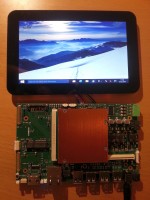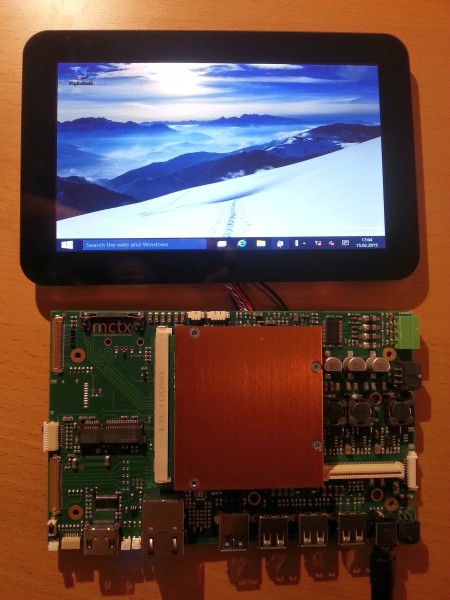Highly integrated electronics platform for x86 and ARM-based multi-display applications and touch control units
The MX-Q7-MM2 enables a large number of common IO scenarios in the area of visualization and user interface applications - with an optimized unit price and without costly hardware designs.
The rapid rise in market penetration of tablet PCs in the consumer market has led to control units with multimedia features being regarded as a basic requirement for the market success of the respective devices in a large number of market segments. The MX-Q7-MM2 board addresses these application areas.
Example configuration: ARM-based multi-display application with three 12" displays and MIPI camera:
The following video shows the MX-Q7-MM2 equipped with a freescale i.MX6 based conga-QMX6 Qseven module in a multi-display configuration with 3 TFT displays (12", 1280x800) and MIPI camera under Linux/YOCTO:
Beispiel-Konfiguration: x86-basierte Mulitouch-Anwendung:
MX-Q7-MM2 platform equipped with Intel Atom Qseven module (conga-QA3) and 7" multi-touch display, Windows 10 application:

Concept
Even in the basic configuration, the MX-Q7-MM2 offers a large number of peripheral interfaces and, if necessary, can be adapted to the needs of a specific requirement using equipment options. In addition, an expansion slot is available, which can be used to implement additional performance features that go beyond the functional area of the board. The MX-Q7-MM2 is very flat to enable a slim product design.
processor platforms
The MX-Q7-MM2 is designed for use with low cost, standardized CPU modules according to the Qseven 2.0 industry standard. This makes it possible to adapt the system as best as possible to the requirements of the application and the required operating system. The CPU options are processors from the current Intel Atom product families (Braswell, Baytrail) and AMD Embedded G-Series (Fusion) in the x86 area, and various derivatives of the freescale i.MX6 and nVIDIA Tegra product families in the ARM area. On the operating system side, the current Microsoft Windows operating systems (standard and embedded versions) as well as Linux and Android are supported.
Peripheral Interfaces
The MX-Q7-MM2 can be operated with an input voltage of 24V and offers a variety of peripheral interfaces such as Ethernet, USB, CAN, RS-485, I2C, UART, LVDS, 24V digital I/O, and audio. There is an RFID/NFC reader on the system board especially for the user ID area.
There are also configuration options such as a digital display interface, up to 6 additional USB channels, an expansion slot for mSATA SSD storage media, an additional micro SD card slot, an integrated stereo audio amplifier, and an ambient light sensor for controlling the brightness of the display backlight. When fully expanded, the MX-Q7-MM2 supports the operation of up to 3 independent, high-resolution displays and audio support.
Industrial Connectors
In addition to the standard connectors for Ethernet, USB and display interfaces, industrial-grade Molex connectors with a snap-in function are used for the power supply and I/O interfaces.
Functional extensions over the course of the product life cycle
In the course of a product's life cycle, it is often necessary to add new functions to it, e.g. to reflect market trends, or to create new product variants. A module slot is provided for this purpose, via which a large number of functions can be implemented by plugging in an additional module without changing the system board.




